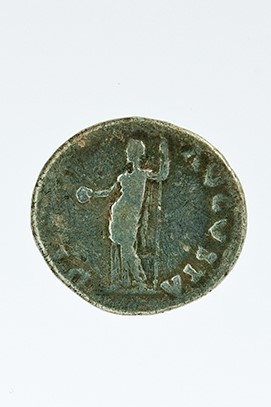Title: Denarius of Galba - 1972.07
Acquisition number: 1972.07
Author or editor: Beryl Rawson
Culture or period: Roman Imperial
Date: AD 68
Material: Metal - Silver
Object type: Coins - Roman
Dimensions: 17mm (w)
Origin region or location: Italy
Origin city: Rome
Display case or on loan: 7
Keywords: Coin, denarius, Roman, Imperial, Galba, Livia
Seaby, H.A., Roman Silver Coins (London, B.A. Seaby, 1967) 52a; Mattingly, H.,Coins of the Roman Empire in the British Museum, 6 vols (London, 1965) 5.
1972.07
Denarius of Galba
2.880 g. AD 68
Obv.: Head of Galba r., laureate. IMP(erator) SER(uius) GALBA AVG(ustus).
Rev.: Female figure (Livia) standing l., holding a patera (shallow dish for offerings) in right hand and long sceptre in left. DIVA AVGVSTA.
Servius Sulpicius Galba was governor in Spain when there was a revolution in Gaul against Nero in AD 68. He was subsequently acclaimed emperor, and issued coins from Spanish and Gallic mints as well as at Rome. This coin came from the Roman mint, but the same type (with variations on the obverse) was issued frequently from all three centres, in all three metals.
Many of the coin types of Galba are frequent throughout the ‘Year of the Four Emperors’, e.g. LIBERTAS P(opuli) R(omani) — cf. 1972.08, Vitellius’ LIBERTAS RESTITVTA. But the Livia reverse is special to Galba. Livia’s patronage had helped Galba’s career greatly, and she left him a large sum in her will (Suetonius Galba 5.2). He thus paid her great honour. He is probably also trying to win respectability for his new regime by establishing his connection with the family of the first emperor, Augustus. Livia had been deified by Claudius, and had appeared as DIVA AVGVSTA on his coins.
Many writers comment on the high artistic standard of coins under Galba and the fidelity of his portraits (e.g. Breglia 82, Sutherland (1974) 174.
Seaby, H.A., Roman Silver Coins (London, B.A. Seaby, 1967) 52a; Mattingly, H.,Coins of the Roman Empire in the British Museum, 6 vols (London, 1965) 5.

